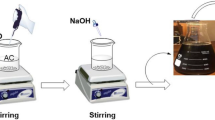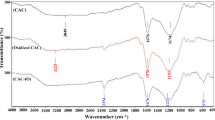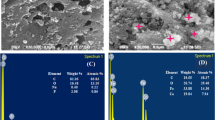Abstract
The recycling of waste materials for production of innovative materials is considered as an interesting point of research and urged the scientists to deal with. This study focuses on the preparation of activated carbon (AC) from sugarcane bagasse waste material. Also, AC/magnetite nanocomposite was prepared by chemical precipitation of magnetite on the prepared AC. The synthesized AC and AC/magnetite were utilized as adsorbents for removal of crystal violet basic dye (CV) from wastewater. The prepared AC and AC/magnetite were investigated by surface area analyzer, X-ray diffraction, Fourier transform infrared spectroscopy (FT-IR), and Raman spectroscopy. To investigate the adsorption of CV by synthesized AC and AC/magnetite, batch adsorption process was conducted with varying different parameters as pH, contact time, and the dose of adsorbents. The equilibrium isotherm was examined by Langmuir and Freundlich models. Moreover, the adsorption kinetic was explored using pseudo-first-order and pseudo-second-order models. The results showed that the AC and AC/magnetite nanocomposite were successfully prepared by the proposed methods. AC/magnetite composite exhibited higher removal percentage (95.6%) for CV from wastewater than AC alone (92%) and the adsorption process proceeded by Freundlich isotherm. The obtained adsorption kinetic data indicated that the process fitted with pseudo-second-order model. The findings of this study recommend that AC and AC/magnetite nanocomposite could be used successfully for the removal of CV from wastewater.


















Similar content being viewed by others
References
Rai P, Gautam RK, Banerjee S, Rawat V, Chattopadhyaya MC (2015) Synthesis and characterization of a novel SnFe2O4 @ activated carbon magnetic nanocomposite and its effectiveness in the removal of crystal violet from aqueous solution. J Environ Chem Eng 3(4):2281–2291
Kakavandi B, Kalantary RR, Jafari AJ, Nasseri S, Ameri A, Esrafili A, Azari A (2015) Pb (II) adsorption onto a magnetic composite of activated carbon and superparamagnetic Fe3O4 nanoparticles: experimental and modeling study. CLEAN–Soil, Air, Water 43(8):1157–1166
Ahsaine HA, Zbair M, Anfar Z, Naciri Y, El Alem N, Ezahri M (2018) Cationic dyes adsorption onto high surface area ‘almond shell’activated carbon: kinetics, equilibrium isotherms and surface statistical modeling. Materials Today Chemistry 8:121–132
Adegoke KA, Bello OS (2015) Dye sequestration using agricultural wastes as adsorbents. Water Resources and Industry 12:8–24
Cheah WK, Ooi CH, Yeoh FY (2016) Rice husk and rice husk ash reutilization into nanoporous materials for adsorptive biomedical applications: a review. Mesoporous Biomater 3:27–38
González-García P (2018) Activated carbon from lignocellulosics precursors: a review of the synthesis methods, characterization techniques and applications. Renew Sust Energ Rev 82:1393–1414
Laurent S, Forge D, Port M, Roch A, Robic C, Vander Elst L, Muller RN (2008) Magnetic iron oxide nanoparticles: synthesis, stabilization, vectorization, physicochemical characterizations, and biological applications. Chem Rev 108(6):2064–2110
Zawrah MF, El Shereefy ESE, Khudir AY (2019) Reverse precipitation synthesis of ≤10 nm magnetite nanoparticles and their application for removal of heavy metals from water. Silicon 11(1):85–104
Demiral H, Güngör C (2016) Adsorption of copper (II) from aqueous solutions on activated carbon prepared from grape bagasse. J Clean Prod 124:103–113
Zahoor M, Khan FA (2018) Adsorption of aflatoxin B1 on magnetic carbon nanocomposites prepared from bagasse. Arab J Chem 11(5):729–738
Chakraborty S, Chowdhury S, Saha PD (2011) Adsorption of crystal violet from aqueous solution onto NaOH-modified rice husk. Carbohydr Polym 86(4):1533–1541
Senthilkumar T, Raghuraman R, Miranda LR (2013) Parameter optimization of activated carbon production from Agave sisalana and Punica granatum peel: adsorbents for CI reactive orange for removal from aqueous solution. CLEAN–Soil, Air, Water 41(8):797–807
Önal Y (2006) Kinetics of adsorption of dyes from aqueous solution using activated carbon prepared from waste apricot. J Hazard Mater 137(3):1719–1728
Da Silva Lacerda V, López-Sotelo JB, Correa-Guimarães A, Hernández-Navarro S, Sánchez-Báscones M, Navas-Gracia LM, Martín-Gil J (2015) Rhodamine B removal with activated carbons obtained from lignocellulosic waste. J Environ Manag 155:67–76
Brito MJP, Veloso CM, Santos LS, Bonomo RCF, Fontan RDCI (2018) Adsorption of the textile dye Dianix® royal blue CC onto carbons obtained from yellow mombin fruit stones and activated with KOH and H3PO4: kinetics, adsorption equilibrium and thermodynamic studies. Powder Technol 339:334–343
Indhu S, Muthukumaran K (2018) Removal and recovery of reactive yellow 84 dye from wastewater and regeneration of functionalised Borassus flabellifer activated carbon. J Environ Chem Eng 6(2):3111–3121
Castro CS, Guerreiro MC, Gonçalves M, Oliveira LC, Anastácio AS (2009) Activated carbon/iron oxide composites for the removal of atrazine from aqueous medium. J Hazard Mater 164(2–3):609–614
Yao S, Liu Z, Shi Z (2014) Arsenic removal from aqueous solutions by adsorption onto iron oxide/activated carbon magnetic composite. J Environ Health Sci Eng 12(1):58
Saka C (2012) BET, TG–DTG, FT-IR, SEM, iodine number analysis and preparation of activated carbon from acorn shell by chemical activation with ZnCl2. J Anal Appl Pyrolysis 95:21–24
Hamidzadeh S, Torabbeigi M, Shahtaheri SJ (2015) Removal of crystal violet from water by magnetically modified activated carbon and nanomagnetic iron oxide. J Environ Health Sci Eng 13(1):8
Hameed B (2008) Equilibrium and kinetic studies of methyl violet sorption by agricultural waste. J Hazard Mater 154(1–3):204–212
Awasthi GP, Bhattarai DP, Maharjan B, Kim KS, Park CH, Kim CS (2019) Synthesis and characterizations of activated carbon from Wisteria sinensis seeds biomass for energy storage applications. J Ind Eng Chem 72:265–272
Kim W, Suh CY, Cho SW, Roh KM, Kwon H, Song K, Shon IJ (2012) A new method for the identification and quantification of magnetite–maghemite mixture using conventional X-ray diffraction technique. Talanta 94:348–352
Darezereshki E (2011) One-step synthesis of hematite (α-Fe2O3) nano-particles by direct thermal-decomposition of maghemite. Mater Lett 65(4):642–645
Pradhan S (2011) Production and characterization of activated carbon produced from a suitable industrial sludge (Doctoral dissertation)
Baysal M, Bilge K, Yılmaz B, Papila M, Yürüm Y (2018) Preparation of high surface area activated carbon from waste-biomass of sunflower piths: kinetics and equilibrium studies on the dye removal. J Environ Chem Eng 6(2):1702–1713
Reza RA, Ahmaruzzaman M (2015) A novel synthesis of Fe2O3@ activated carbon composite and its exploitation for the elimination of carcinogenic textile dye from an aqueous phase. RSC Adv 5(14):10575–10586
Cheng S, Zhang L, Ma A, Xia H, Peng J, Li C, Shu J (2018) Comparison of activated carbon and iron/cerium modified activated carbon to remove methylene blue from wastewater. J Environ Sci 65:92–102
Ma J, Zhu Z, Chen B, Yang M, Zhou H, Li C et al (2013) One-pot, large-scale synthesis of magnetic activated carbon nanotubes and their applications for arsenic removal. J Mater Chem A 1(15):4662–4666
Guo C, Hu Y, Qian H, Ning J, Xu S (2011) Magnetite (Fe3O4) tetrakaidecahedral microcrystals: synthesis, characterization, and micro-Raman study. Mater Charact 62(1):148–151
De Faria DLA, Venâncio Silva S, De Oliveira MT (1997) Raman microspectroscopy of some iron oxides and oxyhydroxides. J Raman Spectrosc 28(11):873–878
Yao S, Zhang J, Shen D, Xiao R, Gu S, Zhao M, Liang J (2016) Removal of Pb (II) from water by the activated carbon modified by nitric acid under microwave heating. J Colloid Interface Sci 463:118–127
da Silva LA, Borges SMS, Paulino PN, Fraga MA, de Oliva ST, Marchetti SG, do Carmo Rangel M (2017) Methylene blue oxidation over iron oxide supported on activated carbon derived from peanut hulls. Catal Today 289:237–248
Ahmad R (2009) Studies on adsorption of crystal violet dye from aqueous solution onto coniferous pinus bark powder (CPBP). J Hazard Mater 171(1–3):767–773
Porkodi K, Kumar KV (2007) Equilibrium, kinetics and mechanism modeling and simulation of basic and acid dyes sorption onto jute fiber carbon: eosin yellow, malachite green and crystal violet single component systems. J Hazard Mater 143(1–2):311–327
Foo KY, Hameed BH (2010) Insights into the modeling of adsorption isotherm systems. Chem Eng J 156(1):2–10
AbdEl-Salam AH, Ewais HA, Basaleh AS (2017) Silver nanoparticles immobilised on the activated carbon as efficient adsorbent for removal of crystal violet dye from aqueous solutions. A kinetic study. J Mol Liq 248:833–841
Park HS, Koduru JR, Choo KH, Lee B (2015) Activated carbon impregnated with iron oxide nanoparticles for enhanced removal of bisphenol A and natural organic matter. J Hazard Mater 286:315–324
Hao Z, Wang C, Yan Z, Jiang H, Xu H (2018) Magnetic particles modification of coconut shell-derived activated carbon and biochar for effective removal of phenol from water. Chemosphere 211:962–969
Lompe KM, Menard D, Barbeau B (2017) The influence of iron oxide nanoparticles upon the adsorption of organic matter on magnetic powdered activated carbon. Water Res 123:30–39
Sun P, Hui C, Khan RA, Du J, Zhang Q, Zhao YH (2015) Efficient removal of crystal violet using Fe3O4-coated biochar: the role of the Fe3O4 nanoparticles and modeling study their adsorption behavior. Sci Rep 5:12638
Aranfil T, Kilduff JE (1999) Role of granular activated carbon surface chemistry on the adsorption of organic compounds. 1. Priority pollutants. Environ Sci Technol 33(18):3217–3224
Lucas IT, Durand-Vidal S, Dubois E, Chevalet J, Turq P (2007) Surface charge density of maghemite nanoparticles: role of electrostatics in the proton exchange. J Phys Chem C 111(50):18568–18576
Sing KS (1985) Reporting physisorption data for gas/solid systems with special reference to the determination of surface area and porosity (Recommendations 1984). Pure Appl Chem 57(4):603–619
Sreńscek-Nazzal J, Narkiewicz U, Morawski AW, Wróbel RJ, Michalkiewicz B (2016) The increase of the microporosity and CO2 adsorption capacity of the commercial activated carbon CWZ-22 by KOH treatment. In: Microporous and mesoporous materials. Open science/open minds. INTECH, pp 2–19. https://doi.org/10.5772/63672
Ho YS, McKay G (1999) Pseudo-second order model for sorption processes. Process Biochem 34(5):451–465
Dhmees AS, Rashad AM, Eliwa AA, Zawrah MF (2019) Preparation and characterization of nano SiO2@CeO2 extracted from blast furnace slag and uranium extraction waste for wastewater treatment. Ceram Int 45:7309–7317
Author information
Authors and Affiliations
Corresponding author
Additional information
Publisher’s note
Springer Nature remains neutral with regard to jurisdictional claims in published maps and institutional affiliations.
Rights and permissions
About this article
Cite this article
Zawrah, M.F., Halkaha, M.A., Eldessouky, M.M.I. et al. Utilization of bagasse waste for production of AC and AC/Fe3O4 composite for removal of dye from wastewater. Biomass Conv. Bioref. 13, 1127–1141 (2023). https://doi.org/10.1007/s13399-020-01169-z
Received:
Revised:
Accepted:
Published:
Issue Date:
DOI: https://doi.org/10.1007/s13399-020-01169-z




